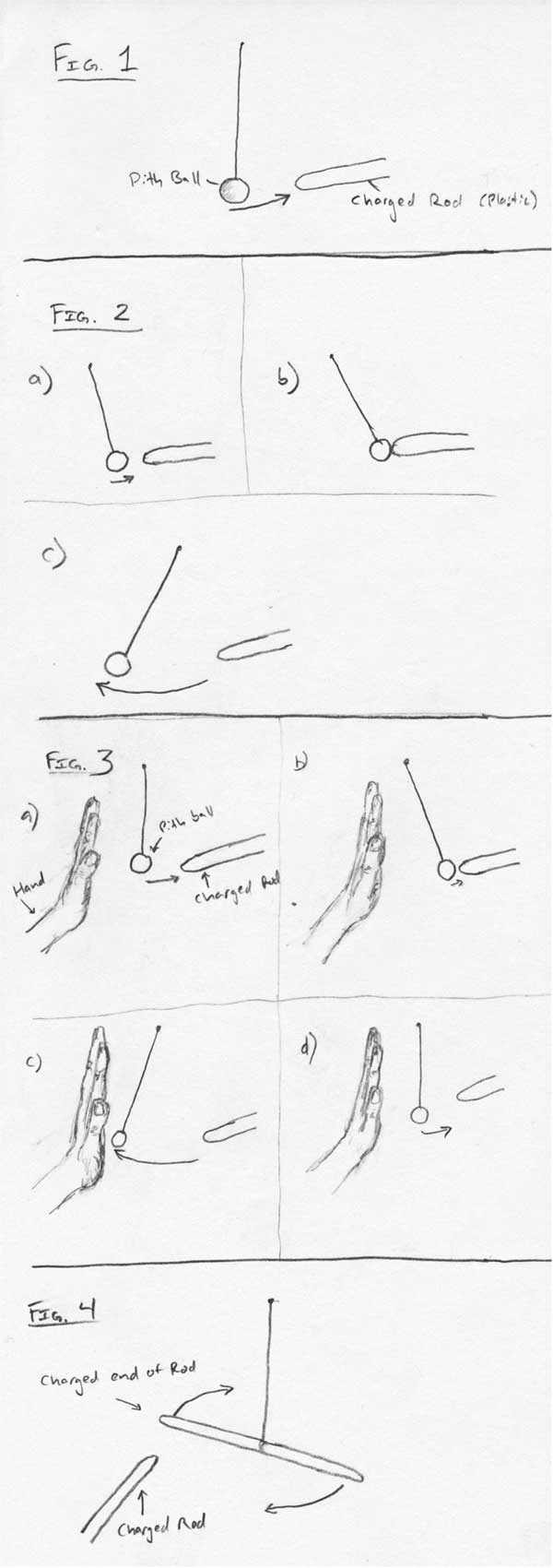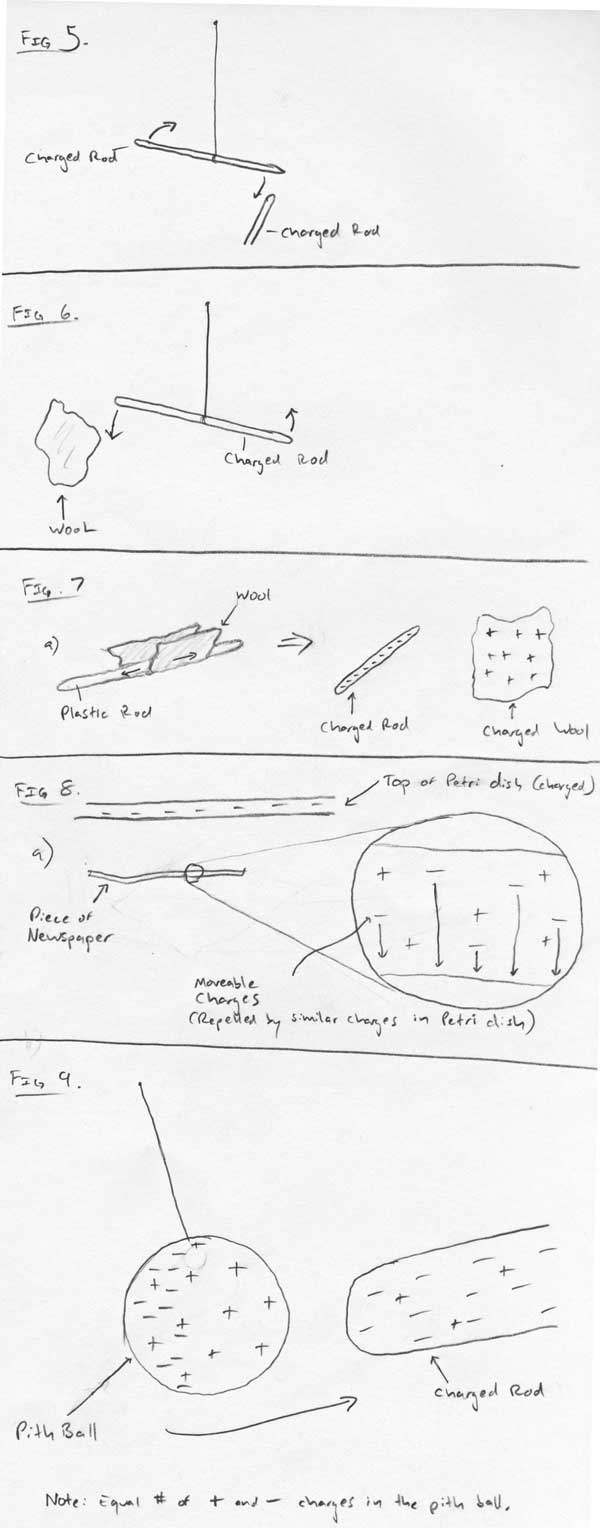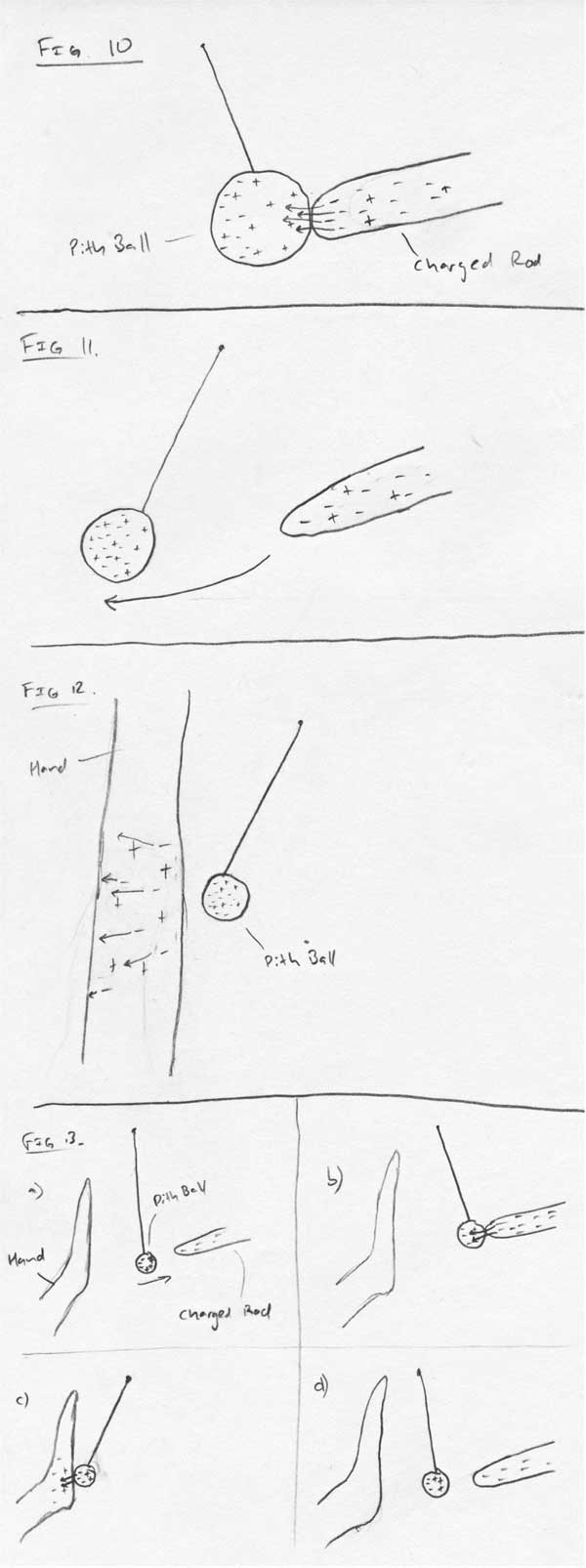Sample Lab Writeup for ‘Invisible Tension’
- Title and Intro (Purpose)
- Materials and Procedure
- Observed Results and Data
- Analysis and Conclusions
Title:
Record a short descriptive title for the experiment.
Intro:
State in a sentence or two the overall purpose of the experiment. Include any background information that would help someone to understand the context surrounding the experiment.
The question to answer is: “Why are you doing this particular experiment?” and “What are the primary phenomena you are trying to explore?”
Materials and Procedure:
List all materials used, and any pertinent information about the materials as well.
The question here is: “What are the things involved in the experiment?” Then explain how the materials are set up in relation to each other, and what you did with the materials so that any other reasonably intelligent person could re-create your experiment. Include a drawing of the setup if appropriate (it generally is). DO NOT tell “what happened” when you performed the experiment, just explain how it was set up and the steps needed to run the experiment. Usually the basis for this will already be provided for you in the lab handout or instructions. A description of “What happened” goes in section 3, observed results and data.
The question is: “How are the materials set up in relation to each other?” and “What did you actually do with the materials?”
Part One: First we tore up a newspaper into small bits about 1cm square. Then we rubbed a plastic rod with wool and brought it near the pieces of paper.
Part Two: Then we suspended a pith ball in the air by a thread and brought a rod that had not been rubbed towards the ball. Then, after rubbing the plastic rod with wool, we brought it near the pith ball again. We touched the pith ball with the rod, removed the rod, and slowly brought a hand near the ball. Then, after making sure to touch the pith ball with a hand, we brought a rubbed plastic rod towards it from one side while bringing a hand towards it simultaneously from the other side. Lastly, we touched the pith ball and brought a rubbed plastic rod near the ball until it touched it and was repelled. Then we rubbed a glass rod with silk and brought it near the pith ball. Then we did the same experiment but this time started with the glass rod first.
Part Three: We suspended a rubber rod from its center so that it hung in the air horizontally, and rubbed only one side of the rod with wool. Then we rubbed one end of another rubber rod and brought it near one end of the suspended rod, then the other. Then we brought the unrubbed end towards each end of the suspended rod, then tried the same with a glass rod rubbed with silk.
Observations and Data:
State exactly “what happened” when the experiment was performed. Tell only what you observed with your external senses (sight, hearing, taste, smell, touch, etc). DO NOT speculate on “why” it happened, simply state the results of that occurred when you carried out your procedure.. If you have technical data, please record the data in a table that is clearly labeled. Include drawings (with labels) and charts or graphs (with labels) if they help communicate the facts.
Part Two: When we brought the unrubbed rod towards the pith ball, nothing unusual happened, but when the rod had been rubbed with wool, the pith ball was attracted towards the rod and moved in its direction, until finally it touched the rod (figure 1). When it touched the rod, the ball immediately jumped away from the rod, as if it were being repelled (figure 2). We could chase the ball around with the rod and it always seemed to try and maximize its distance from the rod. Then we brought a hand near the pith ball, and the ball was slightly attracted, and eventually came up to and touched the hand, at which point the ball seemed to lose all attractive or repulsive effects. Lastly, when we brought a plastic rod rubbed with wool towards the ball while bringing a hand towards it from the other side, the pith ball first was attracted to the rod just like earlier in the experiment when we didn’t have a hand present, but then as soon as the pith ball touched the rod it bounced off and hit the hand. After it hit the hand it swung back towards the center and was again attracted to the rod. It touched the rod and bounced off and hit the hand again, repeating the cycle (figure 3). Sometimes the ball would ‘stick’ to the rod and wouldn’t automatically bounce off. In the last experiment of part two, we observed that when the pith ball was touched with a rubbed plastic rod it was repelled from the rod, but was then attracted to the glass rod rubbed with silk. When we started by touching the pith ball with the glass rod, it was then subsequently attracted to the rubbed plastic rod.
Part Three: When we brought a rubbed plastic rod near the rubbed end of the suspended rod, the suspended rod started to rotate so that it moved away from the rod we were holding (figure 4). When we brought the rod towards the end of the suspended rod that wasn’t rubbed, the suspended rod twisted towards the rod we held as if it were attracted to it (figure 5). When we rubbed a glass rod with silk and brought it near the rubbed end of the suspended rod, the suspended rod seemed very slightly attracted to the glass rod. The rubbed glass rod seemed to also very slightly attract the non-rubbed end of the plastic rod, but the effect was even less noticeable. When we brought the wool that had been rubbed on a plastic rod towards the rubbed end of the suspended rod, the suspended rod was definitely attracted towards the wool (figure 6).
Analysis and Conclusion:
Here is where you can “interpret” and explain your results. Include any ideas on why you observed what you did, and any ways you could improve the experiment by noting sources of error. In particular, include any unexpected, unusual, or important aspects, as well as reasons why your hypothesis was or was not accurate.
So we can say that the newspaper bits were attracted to the Petri dish because some of the charge in the newspaper was attracted to the other type of charge that was created in the plastic Petri dish by rubbing it with wool. The reason why there is a net attraction is due to the fact that some amount of the charges in the newspaper have the ability to move around. This allows for a little bit of separation of charge inside the newspaper, so that overall there is a charge imbalance inside the newspaper (figure 8).
Part Two: The pith ball is initially attracted to the charged rod for the same reason that the newspaper bits were attracted to the Petri dish: some of the charge in the ball was attracted to the opposite charge in the rod (figure 9). When the ball actually touched the rod, some of the moveable charges actually transferred from the rod to the ball (figure 10). When this occurred, the pith ball had more of one type of charge than the other, so it had a net charge that was the same as the net charge of the rod. In a situation where you have two things of like charge, they each repel the other, so the pith ball immediately bounced off the rod and continued to be repelled by it (figure 11). But when we brought a hand, which has some moveable charges in it as well, near the pith ball that had a net imbalance, the pith ball was attracted to the hand (figure 12). This is in fact just the same as bringing a charged rod near a neutral pith ball, but in this case the charged object is small (the pith ball) and the neutral object (the hand) is big, so instead of the hand moving, the pith ball does. This provides us with an explanation for what occurs when you bring a charged rod and a large neutral object towards a pith ball from opposite sides (figure 13). Initially the pith ball is attracted towards the rod, as explained above. Then the pith ball finally touches the rod, and is repelled, as explained above. Then the pith ball, bring repelled by the rod, swings over towards the hand, to which it is slightly attracted. The pith ball then touches the hand, and some of the excess charges on the pith ball are transferred to the hand, so that the pith ball becomes neutral again, while the hand, because it is so large, also remains basically neutral. Then the pith ball is essentially back in the original position of being neutral and attracted to the rod, so the whole process repeats until enough of the charge on the rod is transferred over to the hand (via the pith ball) to make the attraction between the neutral pith ball and the rod not enough to cause it to move significantly. For the last experiment of part two, the pith ball is initially attracted to the plastic rod as stated above, then when it touches the rod charge is transferred to the pith ball and they become similarly charged and so repel each other. Then when the rubbed glass rod is brought near the pith ball the pith ball was strongly attracted to the rod. This must mean that the glass rod was charged oppositely to the pith ball. This is evidence for the existence of two types of charge, which we call positive and negative.
Part Three: A suspended plastic rod that has been rubbed by wool is repelled by another rubbed plastic rod because each rod has the same type of excess charge, and excess charges repel each other (figure 14). When we brought a rubbed plastic rod near the uncharged end of a suspended plastic rod the rod was attracted, for the same reason that newspaper and the pith ball were attracted to the rubbed plastic rod: some of the moveable charges in the suspended rod moved around so that there was a net attraction (figure 15). The suspended rod that had been rubbed was attracted to the wool because the wool was charged oppositely to the rod, and opposite charges attract each other (figure 16).Figures:



